This article needs additional citations for verification .(September 2017) |
 Cover | |
| Genre | Role-playing game |
|---|---|
| Publisher | Judges Guild |
| Media type | |
Dragon's Hall is a supplement for fantasy role-playing games published by Judges Guild in 1981.
This article needs additional citations for verification .(September 2017) |
 Cover | |
| Genre | Role-playing game |
|---|---|
| Publisher | Judges Guild |
| Media type | |
Dragon's Hall is a supplement for fantasy role-playing games published by Judges Guild in 1981.
Dragon's Hall includes a solo dungeon scenario for character levels 1-2. It was designed for one player with one to four characters. [1]
Dragon's Hall was written by Jim Simon, and was published by Judges Guild in 1981 as a 16-page book. [1]
Lewis Pulsipher reviewed the adventure in The Space Gamer No. 54. [2] Pulsipher commented: "The game is not suited to solo play for two reasons. First, low-level characters are two easy to kill or incapacitate. Second, the first-level Sleep spell is too powerful, but other spells are too weak or too variable of effect to be woven into a solo dungeon." [2] He continued: "Simon then tries to get around the vulnerability problems by allowing up to four adventurers – most solos accommodate only one. He also allows spell-casters (most solos do not), with a limited choice of spells, but Sleep and Cure are included (even if the character can't normally use Sleep), so that a smart player will almost certainly take only these spells. Moreover, I noticed no case in which any magic spell other than Sleep would have approached its effectiveness, nor were any clerical spells other than Cure of much use." [2] Pulsipher added: "Although the introduction warns that low-level characters are sometimes better off running than fighting, in cases where a fight option is given, it almost always fails. In other cases it is not even offered. Because of this, and because the adventurers are trapped in the dungeon by a cave-in, with only one way out located at an unknown and distant place, they must fight through most of the monsters in the dungeon in order to leave. I can't imagine any party of second-levels, let alone firsts, likely to survive this test." [2] He commented "Although paragraphs have a number-letter designation, as in most solos, the number does not correspond to the page number. The editorial failure to re-number paragraphs is inexcusable. It certainly increases the tedium associated with the paragraph-finding method." [2] Pulsipher concluded his review by saying, "With nothing particularly imaginative to recommend it, and marks against it such as indifferent layout, poor word-to-cost ratio, and the unsuitability of AD&D to solo dungeons, I cannot recommend Dragon's Hall at this price, even to those who like solos." [2]
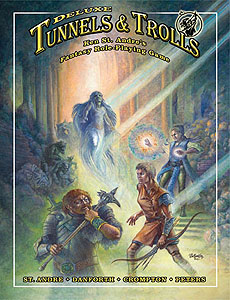
Tunnels & Trolls is a fantasy role-playing game designed by Ken St. Andre and first published in 1975 by Flying Buffalo. The second modern role-playing game published, it was written by Ken St. Andre to be a more accessible alternative to Dungeons & Dragons and is suitable for solitaire, group, and play-by-mail gameplay.
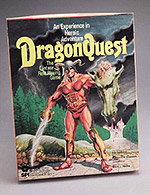
DragonQuest is a fantasy role-playing game originally published by Simulations Publications (SPI) in 1980. Where first generation fantasy role-playing games such as Dungeons & Dragons (D&D) restricted players to particular character classes, DragonQuest was one of the first games to utilize a system that emphasized skills, allowing more individual customization and a wider range of options.

Pool of Radiance is a role-playing video game developed and published by Strategic Simulations, Inc (SSI) in 1988. It was the first adaptation of TSR's Advanced Dungeons & Dragons (AD&D) fantasy role-playing game for home computers, becoming the first episode in a four-part series of D&D computer adventure games. The other games in the "Gold Box" series used the game engine pioneered in Pool of Radiance, as did later D&D titles such as the Neverwinter Nights online game. Pool of Radiance takes place in the Forgotten Realms fantasy setting, with the action centered in and around the port city of Phlan.

Pools of Darkness is a role-playing video game published by Strategic Simulations in 1991. The cover art and introduction screen shows a female drow. It is the fourth entry in the Pool of Radiance series of Gold Box games, and the story is a continuation of the events after Secret of the Silver Blades. The novel loosely based on the game was released in 1992. Like the previous games in the series, it is set in the Forgotten Realms, a campaign setting from Dungeons & Dragons. Players must stop an invasion from an evil god, eventually traveling to other dimensions to confront his lieutenants.
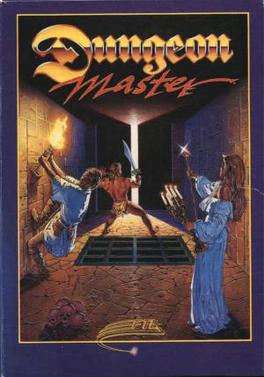
Dungeon Master is a role-playing video game featuring a pseudo-3D first-person perspective. It was developed and published by FTL Games for the Atari ST in 1987, almost identical Amiga and PC (DOS) ports following in 1988 and 1992.
The magic in Dungeons & Dragons consists of the spells and magic systems used in the settings of the role-playing game Dungeons & Dragons (D&D). D&D defined the genre of fantasy role-playing games, and remains the most popular table-top version. Many of the original concepts have become widely used in the role-playing community across many different fictional worlds, as well as across all manner of popular media including books, board games, video games, and films.

D&D Adventurers League is the organized play association for the Dungeons & Dragons (D&D) roleplaying game which is officially administered by D&D's publisher, Wizards of the Coast. It was rebranded with the launch of D&D's 5th Edition in 2014. Prior to 2014, it was known as the Role Playing Game Association Network. The organization was originally established by D&D's previous publisher, TSR, Inc., in 1980.

Dungeons & Dragons: Tower of Doom, published in 1994, is the first of two arcade games created by Capcom based on the Dungeons & Dragons tabletop role-playing game and set in the Mystara campaign setting. It is a side scrolling beat 'em up with some role-playing video game elements for one to four players. The game was also released on the Sega Saturn, packaged with its sequel, Dungeons & Dragons: Shadow over Mystara, under the title Dungeons & Dragons Collection, although the Saturn version limited the gameplay to only two players. In 2013, both games were re-released for modern platforms as Dungeons & Dragons: Chronicles of Mystara.
The Ranger is one of the standard playable character classes in most editions of the Dungeons & Dragons fantasy role-playing game. Rangers are skilled bushcraftsmen/woodcraftsmen, and often lived reclusive lives as hermits.
The paladin is one of the standard playable character classes in most editions of the Dungeons & Dragons fantasy role-playing game. The paladin is a holy knight, crusading in the name of good and order, and is a divine spellcaster.
A character class is a fundamental part of the identity and nature of characters in the Dungeons & Dragons role-playing game. A character's capabilities, strengths, and weaknesses are largely defined by their class; choosing a class is one of the first steps a player takes to create a Dungeons & Dragons player character. A character's class affects a character's available skills and abilities. A well-rounded party of characters requires a variety of abilities offered by the classes found within the game.
The cleric is one of the standard playable character class in the Dungeons & Dragons fantasy role-playing game. Clerics are versatile figures, both capable in combat and skilled in the use of divine magic (thaumaturgy). Clerics are powerful healers due to the large number of healing and curative magics available to them. With divinely-granted abilities over life or death, they are also able to repel or control undead creatures. Clerics also have specific 'domains' which usually align with the character's alignment and the god that cleric serves. Whether the cleric repels or controls undead is dependent on the cleric's alignment. It is the only class to be included in every edition of Dungeons & Dragons without a name change.
The wizard is one of the standard character class in the Dungeons & Dragons fantasy role-playing game. A wizard uses arcane magic, and is considered less effective in melee combat than other classes.

Dungeons & Dragons Tactics is a tactical role-playing game released on the PlayStation Portable handheld video game console. It is set in the world of Dungeons & Dragons and uses a strict interpretation of the Dungeons & Dragons 3.5 Edition rule set.

The Magic Item Compendium is a sourcebook written for the 3.5 edition of the Dungeons & Dragons fantasy role-playing game.

High Fantasy is a fantasy role-playing game system originally published by Fantasy Productions in 1978. A second edition in 1981 and several subsequent books were published by Reston Publishing that featured solo adventures using the High Fantasy system. The game received mixed reviews in game periodicals including White Dwarf, The Space Gamer, Different Worlds, Ares, and Dragon.
Pool of Radiance is a series of role-playing video games set in the Forgotten Realms campaign settings of Dungeons & Dragons; it was the first Dungeons & Dragons video game series to be based on the Advanced Dungeons & Dragons rules.
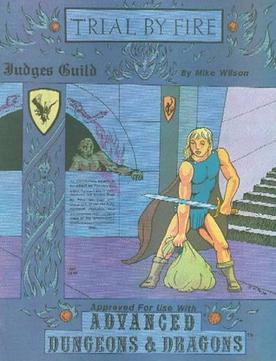
Trial by Fire is an adventure for fantasy role-playing games published by Judges Guild in 1981.
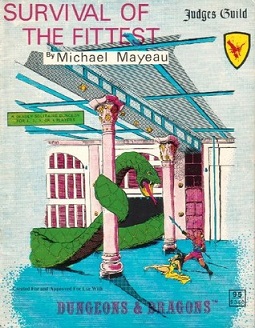
Survival of the Fittest is an adventure for fantasy role-playing games published by Judges Guild in 1979.
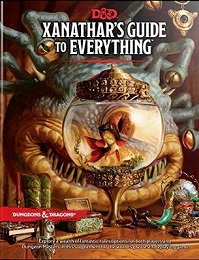
Xanathar's Guide to Everything is a sourcebook published in 2017 for the 5th edition of the Dungeons & Dragons fantasy role-playing game. It acts as a supplement to the 5th edition Dungeon Master's Guide and the Player's Handbook.